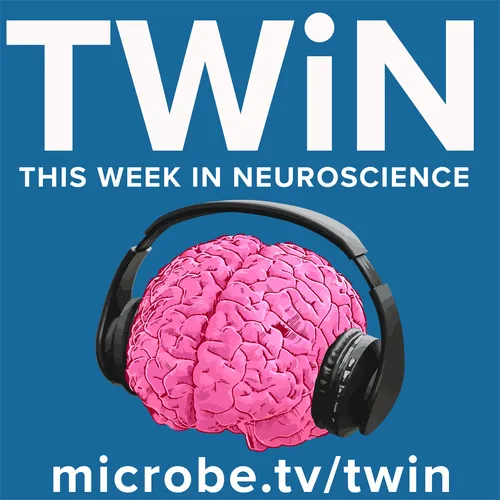
This Week in Neuroscience
A podcast about the nervous system.
- Update frequency
- every 29 days
- Average duration
- 68 minutes
- Episodes
- 62
- Years Active
- 2019 - 2025

TWiN 43: Pavlovian opioid tolerance
TWiN discusses a study of on the pathways that control opioid analgesic tolerance, a root cause of opioid overdose and misuse, which can develop through an associative learning.
Hosts: Vincent Racani…

TWiN 42: Therapeutic effects of psychedelic drugs
TWiN explains how psychedelic drugs such as LSD, psilocybin, and MDMA, which are being explored for treating a wide range of neuropsychiatric diseases, reopen the social reward period for critical le…

TWiN 41: Alzheimer's and melanin-concentrating hormone
Vivianne explains how early in Alzheimer’s disease, the brain attempts to counteract the increased excitatory drive caused by amyloid deposition, and that melanin-concentrating hormone, produced duri…

TWiN 40: Dopamine organizes behavior's syllables
Tim takes TWiN through two studies on the role of dopamine: that syllables are natural units of spontaneous behavior used by the brain to structure action, and that mesolimbic dopamine release convey…

TWiN 39: Virus-like capsids trigger paraneoplastic disease
Junjie from Jason’s lab joins TWiN to discuss the observation that the cell gene PNMA2 encodes non-enveloped virus-like capsids that induce autoantibodies which underlie paraneoplastic syndrome.
Host…

TWiN 38: Bacterial immunity heals sensory neurons
TWiN explains the finding that immunity to commensal bacteria promotes sensory neuron regeneration via the cytokine interleukin-17A.
Hosts: Vincent Racaniello, Ori Lieberman, Timothy Cheung, and Vivi…

TWiN 37: Microglia at the crossroads
TWiN reviews the field of microgial research, which has advanced in recent decades but is constrained by nomenclature that is necessary but often implies specific functions.
Hosts: Vincent Racaniello…

TWiN 36: Unbearable neurologists
TWiN answers listener questions about Alzheimer’s disease, glaucoma and the microbiota, Dravet’s Syndrome, schizophrenia, brain development, and chips implanted in the human brain.
Hosts: Vincent Rac…

TWiN 35: Neuromodulation in treatment-resistant depression
Jason and Tim review the use of an implanted chronic deep brain sensing and stimulation device to carry out biomarker-driven closed-loop therapy that resulted in a rapid and sustained improvement in …

TWiN 34: Microglia vital after spinal cord injury
TWiN explains how central nervous system resident macrophages known as microglia coordinate cellular interactions during spinal cord repair in mice.
Hosts: Vincent Racaniello, Jason Shepherd, Timothy…

TWiN 33: Viruses leaving the brain
TWiN describes how neurotropic viruses leave the brain via meningeal lymphatic vessels located dorsally and basally beneath the skull.
Hosts: Vincent Racaniello, Ori Lieberman, Jason Shepherd, and Ti…

TWiN 32: Relearning how to move after stroke
TWiN reviews how, in a mouse stroke model, recovery of movement is associated with the remaining cortex and the striatum coordinating their activity together.
Hosts: Ori Lieberman, Timothy Cheung, an…

TWiN 31: HIV-1 co-receptor shapes window for memory linking
TWiN explains the observation that in mice, the HIV-1 co-receptor CCR5 closes the temporal window for linking different memories.
Hosts: Vincent Racaniello, Jason Shepherd, Timothy Cheung, and Vivian…

TWiN 30: Gut to brain spread of alpha-synuclein in Parkinson's disease
TWiN describes experiments demonstrating that gut injection of alpha-synuclein fibrils in mice converts endogenous alpha-synuclein to a pathologic form that spreads to the brain and leads to features…

TWiN 29: Astrocytes close the critical period
Hosts: Vincent Racaniello, Jason Shepherd, Timothy Cheung,…

TWiN 28: Oligodendrocyte performance enhancing exosomes
TWiN reveals how oligodendrocytes enhance axonal energy metabolism by transcellular delivery of a protein, SIRT2, that deacetylates mitochondrial proteins.
Hosts: Vincent Racaniello, Timothy Cheung, …

TWiN 27: Eyes wired to the auditory cortex
TWiN discusses the finding that rewiring retinal projections to the auditory thalamus in ferrets leads to visually responsive cells that are typical of cells in the visual cortex.
Hosts: Ori Lieberma…

TWiN 25: Thanks for listening
TWiN answers listener questions on sex in neuroscience studies, rotating memories in the brain, odorant receptors in the brain, and neutrophils that promote neuron survival.
Hosts: Vincent Racaniello…

TWiN 24: Social transmission of maternal behavior with Ioana Carcea and Robert Froemke
Ioana and Robert join TWiN to discuss their work demonstrating that rodents acquire maternal behavior by social transmission from an experienced mother to a virgin female how to care for a litter via…